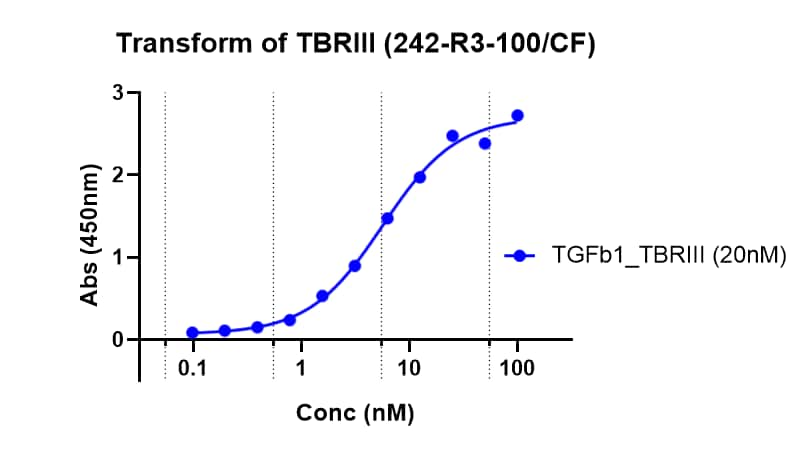Recombinant Human TGF-beta RIII Protein Summary
Product Specifications
Gly21-Asp781
Analysis
Product Datasheets
Carrier Free
CF stands for Carrier Free (CF). We typically add Bovine Serum Albumin (BSA) as a carrier protein to our recombinant proteins. Adding a carrier protein enhances protein stability, increases shelf-life, and allows the recombinant protein to be stored at a more dilute concentration. The carrier free version does not contain BSA.
In general, we advise purchasing the recombinant protein with BSA for use in cell or tissue culture, or as an ELISA standard. In contrast, the carrier free protein is recommended for applications, in which the presence of BSA could interfere.
242-R3
| Formulation | Lyophilized from a 0.2 μm filtered solution in PBS with BSA as a carrier protein. |
| Reconstitution | Reconstitute at 200 μg/mL in sterile PBS containing at least 0.1% human or bovine serum albumin. |
| Shipping | The product is shipped at ambient temperature. Upon receipt, store it immediately at the temperature recommended below. |
| Stability & Storage: | Use a manual defrost freezer and avoid repeated freeze-thaw cycles.
|
242-R3/CF
| Formulation | Lyophilized from a 0.2 μm filtered solution in PBS. |
| Reconstitution | Reconstitute at 200 μg/mL in sterile PBS. |
| Shipping | The product is shipped at ambient temperature. Upon receipt, store it immediately at the temperature recommended below. |
| Stability & Storage: | Use a manual defrost freezer and avoid repeated freeze-thaw cycles.
|
Reconstitution Calculator
Background: TGF-beta RIII
Most cell types express three sizes of receptors for TGF-beta. These are designated Type I (53 kDa), Type II (70 - 85 kDa), and Type III (250 - 350 kDa). The Type I receptor is a membrane-bound serine/threonine kinase that apparently requires the presence of the Type II receptor to bind TGF-beta. The Type II receptor is also a membrane-bound serine/threonine kinase that binds TGF-beta 1 and TGF-beta 3 with high affinity and TGF-beta 2 with a much lower affinity. The Type I and Type II receptors together form a heterodimeric signaling complex that is essential for the transduction of the anti-proliferative signals of TGF-beta.
The Type III receptor is a transmembrane proteoglycan with a large extracellular domain and a 43 amino acid residue cytoplasmic domain. The cytoplasmic domain of the Type III receptor lacks an obvious signaling motif and the receptor may not be involved directly in signal transduction. The Type III receptor binds TGF-beta 2 with the highest affinity. Other TGF-beta isoforms also bind the Type III receptor, but with lower affinities. Cellular responsiveness to TGF-beta 2 appears to be dependent on the presence of the Type III receptor which can interact with the signaling receptor complex. In addition to the transmembrane Type III receptor, a soluble form of the receptor is secreted by some cell types. The physiological role of this soluble receptor remains to be determined. The recombinant TGF-beta soluble receptor Type III binds the TGF-beta isoforms differentially in solution and exhibits TGF-beta antagonistic activities in vitro.
Citations for Recombinant Human TGF-beta RIII Protein
R&D Systems personnel manually curate a database that contains references using R&D Systems products. The data collected includes not only links to publications in PubMed, but also provides information about sample types, species, and experimental conditions.
8
Citations: Showing 1 - 8
Filter your results:
Filter by:
-
Fibroblast, Epithelial and Endothelial Cell-Derived Human Cytomegalovirus Strains Display Distinct Neutralizing Antibody Responses and Varying Levels of gH/gL Complexes
Authors: C Fornara, E Schultz, D Lilleri, F Baldanti, B Ryckman, G Gerna
International Journal of Molecular Sciences, 2023-02-23;24(5):.
Species: Human
Sample Types: Whole Cells
Applications: Bioassay -
Role of Betaglycan in TGF-beta Signaling and Wound Healing in Human Endometriotic Epithelial Cells and in Endometriosis
Authors: AN Mwaura, MA Riaz, JB Maoga, E Mecha, COA Omwandho, G Scheiner-B, I Meinhold-H, L Konrad
Biology, 2022-03-26;11(4):.
Species: Human
Sample Types: Whole Cells
Applications: Bioassay -
TGF-? contamination of purified recombinant GDF15
Authors: OE Olsen, A Skjærvik, BF Størdal, A Sundan, T Holien
PLoS ONE, 2017-11-21;12(11):e0187349.
Species: Human
Sample Types: Whole Cells
Applications: Bioassay -
Bone morphogenetic protein-9 suppresses growth of myeloma cells by signaling through ALK2 but is inhibited by endoglin.
Authors: Olsen O, Wader K, Misund K, Vatsveen T, Ro T, Mylin A, Turesson I, Stordal B, Moen S, Standal T, Waage A, Sundan A, Holien T
Blood Cancer J, 2014-03-21;4(0):e196.
Species: Human
Sample Types: Whole Cells
Applications: Bioassay -
Serine protease HTRA1 antagonizes transforming growth factor-beta signaling by cleaving its receptors and loss of HTRA1 in vivo enhances bone formation.
Authors: Graham J, Chamberland A, Lin Q, Li X, Dai D, Zeng W, Ryan M, Rivera-Bermudez M, Flannery C, Yang Z
PLoS ONE, 2013-09-11;8(9):e74094.
Species: Human
Sample Types: Recombinant Protein
Applications: Bioassay -
Inhibin alpha-subunit and the inhibin coreceptor betaglycan are downregulated in endometrial carcinoma.
Authors: Florio P, Ciarmela P, Reis FM, Toti P, Galleri L, Santopietro R, Tiso E, Tosi P, Petraglia F
Eur. J. Endocrinol., 2005-02-01;152(2):277-84.
Species: Human
Sample Types: Whole Tissue
Applications: Preabsorption -
Transforming growth factor-beta1 regulation of growth zone chondrocytes is mediated by multiple interacting pathways.
Authors: Rosado E, 2019, Schwartz Z, Sylvia VL, Dean DD, Boyan BD
91, 2002-06-12;1590(1):1-15.
Species: Rat
Sample Types: Whole Cells
Applications: Bioassay -
Extracellular domain of TGFbeta type III receptor inhibits angiogenesis and tumor growth in human cancer cells.
Authors: Bandyopadhyay A, 2019, Zhu Y, Malik SN, Kreisberg J, Brattain MG, Sprague EA, Luo J, Lopez-Casillas F, Sun LZ
101205, 2002-05-16;21(22):3541-51.
Applications: ELISA (Standard)
FAQs
No product specific FAQs exist for this product, however you may
View all Proteins and Enzyme FAQsReviews for Recombinant Human TGF-beta RIII Protein
Average Rating: 4 (Based on 1 Review)
Have you used Recombinant Human TGF-beta RIII Protein?
Submit a review and receive an Amazon gift card.
$25/€18/£15/$25CAN/¥75 Yuan/¥2500 Yen for a review with an image
$10/€7/£6/$10 CAD/¥70 Yuan/¥1110 Yen for a review without an image
Filter by:





